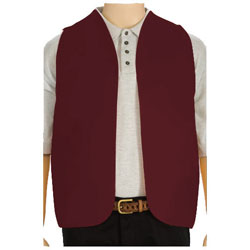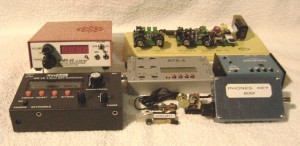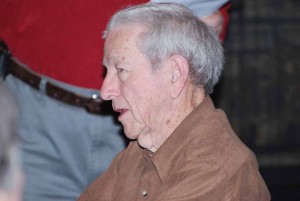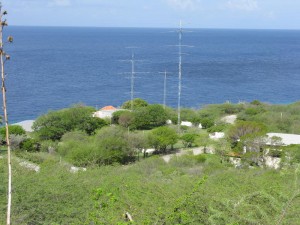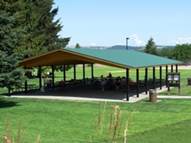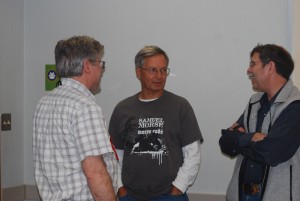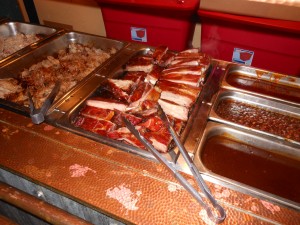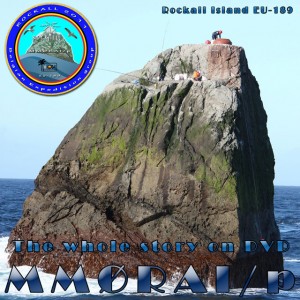.
QRP
OPERATING A STATION AT LOW POWER
_____________________________________________________________________
Definition of QRP
QRP is the term commonly associated with “low power” communications. It is derived from one of the common “Q” signals that means “reduce power”, or “should I reduce power?”
QRP is the operation of a transmitter at power levels that do not exceed 5 watts (CW). Pure QRP operation is when the effective radiated power (ERP), or the calculated power (including all gains and losses), does not exceed 5 watts. Many stations running QRP power levels are also using multi-element directional antennas that actually boost the ERP well above 5 watts. Pure QRP operation is when an operator runs 5 watts or less into an antenna that has no effective gain.
There is some disagreement on what constitutes QRP power for different modes of transmission. Most QRP operators agree that for CW, AM, FM and data modes, the transmitter output should be 5 watts or less. The maximum output power for SSB (single sideband) is not always agreed upon. Some believe that the power should be no more than 10 watts PEP, (Peak Envelope Power), while others hold that the power limit should be 5 watts, period.
Many QRP operators are known to use even less power than five watts, sometimes operating with as little power as 100 milliwatts, and often less. Extremely low power—1 watt and below—is often referred to as QRPp.
Communicating using QRP can be a challenge since the QRP operator must face the same conditions of radio propagation faced by amateurs using higher power levels, but with the inherent disadvantages associated with having a weaker signal on the receiving end. All other factors being equal, QRP operators try to make up for this through more efficient antenna systems and enhanced operating skills.
The practice of operating a radio transmitter at power levels of less than 5 watts is not new. It has only been relatively recently that the idea of QRP operating has gained wide acceptance.
Concepts of QRP Operation
QRP operating can be great fun, but its effectiveness can be a little confusing. Let’s look at the facts:
What would the difference in signal be between a 5 Watt and 100 Watt signal? If the station receiving the 5 Watt signal is indicating an S meter reading of S-5, for example, what would the S meter reading be, if the 5 watt QRP signal was increased to 100 Watts?
What would be the results of the change in power? How would the change affect the resultant change in dB, and thus the change in S meter reading?
The method used to find the amount of change in decibels is to multiply the logarithm (to base 10) of the ratio of the two power quantities by a factor of 10.
10 times the value of log10 (100watts/5watts) = X dB
(The power ratio is 20:1)
We find that log10 (20) = 1.3
10 times the log10 of (20) = 10 times 1.3 = 13dB
Receiver S meters are calibrated to indicate one S unit per 6dB of gain.
Therefore:
13dB/6dB = 2.2 S units
The station’s S-meter reading of S-5 would only increase to an S-7. The normal human ear can typically detect a change in sound volume after about a 12dB increase or decrease. So you would probably just barely notice the difference in the 100 Watts compared to 5 Watts! Of course, the same rules apply to a decrease in power from 100 watts to 5 watts. The effects of the change remain the same, whether the power is increased or decreased.
For the most part, QRP operators use CW as an operating mode. SSB is usually too inefficient for reliable communications under very low power, unless you are using SSB during exceptional operating conditions or under special circumstances. (It should be noted that the ARRL does sponsor a QRP phone contest.) Because QRP takes advantage of the use of CW, QRP is sometimes considered an “elitist” activity among radio operators. That’s exactly what it is! Relatively few operators are running at QRP power levels. That makes QRP operators an “elite” group. It would be great if more hams were using QRP. Unfortunately, many people think QRP operation is not possible during the “low times” of sunspot cycles. This is not true. Just check out K3WWP’s Ham Radio Activities on the internet.
QRP is a “bug”, just like DXing is a bug. Once you are bitten by the QRP bug, you can make operating QRP one of your amateur radio “claims to fame”.
Some of the Benefits of Operating QRP
Here are just a few of the benefits of operating QRP:
• Predominantly CW usage; few QRP operators use SSB, so there is more “room” on the bands
• Less power can mean spending less money for electricity, and that can mean more money for other things
• It improves your listening/operating skills
• There is great satisfaction using 1 watt (or 5 watts) to work that rare DX station
• It gives a new-found appreciation for the hobby
• You can get a “thrill” all over again, just like you felt with your first contact.
• You are following the FCC’s rules of using “the minimum power necessary to carry out the desired communications” by only using enough power to maintain communications.
• It’s a challenge to see how little power you really can get away with
• It’s fun and a challenge
• The use of commercial electricity is not always necessary. (Solar power?)
• No biological hazards associated with QRP–as opposed to QRO (high power)
• You don’t have to worry about RF burns
Further QRP Operating Theory and Benefits
Why is QRP activity predominantly CW? Compare the band space that SSB takes compared to CW. At the very least, SSB requires about 3 kHz (or so) of bandwidth. CW can be used successfully using only about 500 Hz or less of band space. Imagine putting a 5 watt SSB signal on the air. You are going to have to spread those 5 watts over 3 kHz of band space. Now imagine that same 5 watts of RF on the air via a CW signal. Those 5 watts will only have to take up about 500 Hz or so of band space. CW will “concentrate” the RF power, while SSB has to dissipate RF power over a wider range.
More CW operators can fit into a ham band than those using SSB or digital modes. It is much easier to hear one single tone of 800Hz or so, than it is to hear multiple tones or frequencies taking up a space of 3 kHz or more.
CW is much less prone to “lid”-style operation. Being courteous and having good manners is a big issue among operators who use CW.
As you can see, there are quite a few benefits to operating QRP. Besides being a member of a special group of hams who enjoy CW, you could also be a member of a special group of hams who enjoy CW and QRP.
Suggested QRP Link:
•K3WWP’s Ham Radio Activities–one of the best internet ham sites available.
Presented by:
John Kenney, W7COI
2515 N. Atlantic, Spokane, WA 99205
johnkenney@q.com
